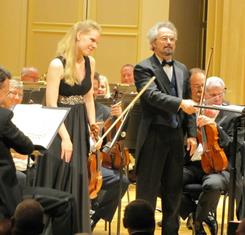
Lamsma, Kalmar Inspire with the CSO
A spectacular debut and the return of a popular guest
conductor marked Friday night’s Cincinnati Symphony Orchestra concert at Music
Hall.

Dutch violinist Simone Lamsma made her CSO debut in the Violin Concerto by Benjamin Britten, a masterpiece that may finally be coming into its own with the Britten centennial this year. The tall, regal Lamsma confirmed that with a performance that touched as well as amazed.
Returning to the CSO podium was Carlos Kalmar, music director of the Oregon Symphony, who led a performance of Carl Nielsen’s Symphony No. 4, “The Inextinguishable,” of such power and insight that its subtitle seemed unusually fitting.
Threading its way through the program was the ever-so-timely theme of dealing with adversity (Boston bombings, disasters worldwide, natural and otherwise). This extended to the opening work, Beethoven’s “Leonore” Overture No. 2, written for his opera “Fidelio” about the rescue of an unjustly imprisoned man.
A committed pacifist, Britten composed his Violin Concerto at
the outset of World War II (it was actually premiered in the U.S. in 1940 at
Carnegie Hall). It brims with emotion -- uncertainty even -- and can be said to
have a tragic cast. The Spanish rhythms which pervade the first
movement are believed to have been suggested by the Spanish Civil War, which
also affected Britten deeply. Much of it is scored in the violin’s highest register
and technical difficulties abound (according to Kyle Gann’s program note, none other
than Jascha Heifetz declared the Concerto unplayable). Lamsma commanded all of
this, from “impossibly” high-lying passages to rapid, fingered harmonics,
left-hand pizzicato and arresting double stops. Underlying all of it was a
luscious, heart-stopping tone, which she projected across the full range of her instrument (a 1718 Stradivarius on loan from an anonymous benefactor).
But there was more than technique to her accomplishment. Britten’s conflicting moods were distinctly presented: the lyrical beauty of the first movement, the gnarly, Prokofievian Vivace (the Scherzo of his Violin Concerto No. 1 comes to mind), and the achingly elegiac finale, which concludes with a soft, unresolved trill by the violin. Kalmar and the CSO were splendid partners, bringing Britten’s colorful orchestration and close interaction with the violin vividly to life.
Niesen’s “Inextinguishable” was
completed in 1916 on the cusp of the First World War. In it, the composer intended
to celebrate the persistence of life in all its forms despite
seeming defeat. Kalmar and the CSO conveyed this brilliantly. Immediately
striking (as it was in the beautifully rendered “Leonore” Overture) was the wide range of
dynamics that characterized the performance. Kalmar made the 60-piece string
section speak in whispered tones when called for, and at the opposite end of the spectrum, drew out a big, burly, lustrous sound.
The childlike second movement (Poco allegretto) was broken by sudden, icy violins to begin the wrenching Adagio, which embodied strife, as well as a hopeful, thrilling climax. The strings’ rapid, scalar surge into the finale signaled all-out war, given visual as well as aural embodiment by timpanists Patrick Schleker and Richard Jensen, who battled it out to the end. And it was a magnificent end, as the symphony’s life-affirming theme returned victorious, prompting a spontaneous ovation from the crowd. Notably, the CSO refused to stand at one point, when Kalmar tried to haul them to their feet to share the crowd’s applause.
In all, it was a thrilling concert tailored to do what music does best, convey the experience of life powerfully and directly.
Repeat is 8 p.m. tonight at Music Hall. Tickets begin at $10. Call (513) 381-3300, or order online at www.cincinnatisymphony.org